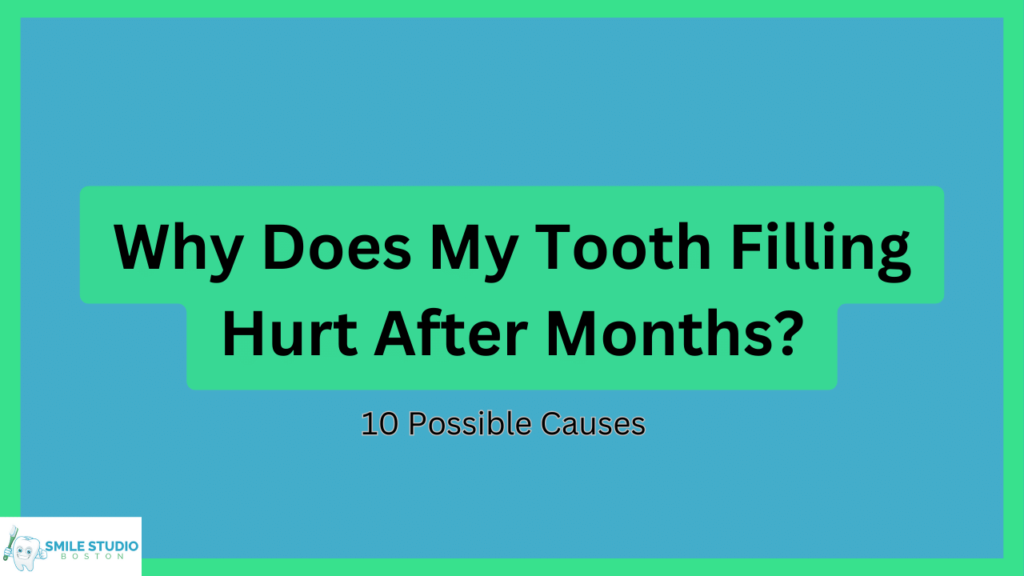Introduction
Why does my tooth filling hurt after months? This is a common question that many dental patients have. Tooth fillings are a routine dental procedure performed to restore the function and morphology of a missing tooth structure, which could be a result of caries or external trauma. However, it’s not uncommon for some patients to experience tooth pain or sensitivity months after getting a filling. This can be concerning and uncomfortable, leading to questions about the long-term effects of dental fillings.
In this blog post, we will explore the reasons behind this phenomenon and provide some insights into how you can manage and prevent post-filling tooth pain. Whether you’ve recently had a filling or are planning to get one, this information will help you understand what to expect and when to seek professional help.
Also Read: How to Relieve Tooth Pain After Filling?
Understanding Tooth Fillings
Tooth fillings, also known as dental fillings, are a common dental procedure used to treat tooth decay.
When a tooth is decayed or damaged, the dentist removes the decayed tooth material, cleans the affected area, and then fills the hollowed-out area of the tooth with a filling material. This process restores the tooth’s shape and prevents further decay by sealing off any cracks or spaces where bacteria might enter.
The purpose of a tooth filling is to restore the function and structure of a damaged tooth, prevent further decay or damage, and improve oral health. Tooth fillings can be made from various materials, most commonly composite (a tooth-colored, resin-based material), amalgam (a silver-colored alloy of metals), gold, or ceramic. The choice of filling material depends on factors such as the tooth location and extent of the decay, aesthetic preferences, and budget.
Now, you might wonder, why does my tooth filling hurt after months? This is a common concern among patients who have had tooth fillings. In the following sections, we will delve into the reasons behind this phenomenon and provide some insights into how you can manage and prevent post-filling tooth pain.
Also Read: What to Do If Your Tooth Filling Fell Out?
Why does My Tooth Filling Hurt After Months:10 Causes
There could be several reasons why your tooth filling hurts after months. Here are 10 possible causes:
1. Incorrect Bite Alignment: An excessively high or uneven filling might cause your teeth to bite awkwardly and place undue pressure on the filled tooth.
2. Decay Around or Beneath the Filling: Deterioration around or beneath a filling may cause sensitivity and pain.
3. Cracks or Damage: A cracked, chipped, or otherwise damaged filling may irritate the nearby tissues and hurt.
4. Gum Recession: Your tooth’s root may become exposed if your gums recede, which might cause sensitivity and pain.
5. Nerve Irritation: When the filling is inserted, the tooth’s nerve may irritate.
6. Allergic Reaction: Some patients may be allergic to a particular material used in the filling, which can make the filled tooth sensitive.
7. Infection: Oral infection can occur after the filling and can cause pain and sensitivity in the teeth.
8. Filling Interfering with the Bite: An incorrectly placed filling or one that is interfering with your bite can break when a patient chews on the food.
9. Fractures or Cracks in the Tooth or Filling: Trauma to the teeth or filling can disclose the nerves and tissues inside the tooth.
10. Tooth Sensitivity: Some people experience tooth sensitivity or pain after a filling due to nerve irritation.
Each of these reasons can contribute to the discomfort you might feel months after getting a dental filling. If you’re experiencing prolonged pain or sensitivity, it’s important to consult with your dentist to identify the cause and discuss appropriate treatment options.
Also Read: How Long Does Dental Filling Pain Last: All You Need to Know
Managing Pain After a Filling
It’s important to know that there are several ways to manage post-filling sensitivity:
Use a Soft-Bristled Toothbrush: This can help avoid irritating the filled tooth or the surrounding gum tissue.
Be Cautious While Flossing: Be gentle while flossing around the filled tooth to prevent dislodging the filling.
Use a Mouth Rinse: Your dentist may recommend using an antimicrobial mouth rinse to help reduce the risk of infection and maintain oral hygiene.
Use a Desensitizing Toothpaste: Special toothpaste designed to treat sensitivity can be beneficial. They contain ingredients that help stop the transmission of pain signals from the tooth exterior to the nerve.
Avoid Temperature Extremes: Minimize exposure to very hot or cold foods and beverages.
Note:
If sensitivity after dental filling persists or is accompanied by severe pain, swelling, or an allergic reaction, it’s important to seek professional dental help. Regular dental visits and a balanced diet are also key to long-term care for filled teeth.
Also read: Understanding the Impact: Can You Smoke After a Dental Filling?
Preventing Tooth-Filling Pain
Preventive measures to avoid tooth filling pain include regular dental check-ups, avoiding hard foods, especially on the side of the filled tooth, and following the instructions given after a tooth filling procedure. Avoid taking sugary snacks and drinks to prevent decay from forming along the margins of the filling.
Regular dental check-ups can help detect decay or damage early on, allowing for timely treatment with a filling. Fillings are generally used for minor tooth decay or damage, although in some circumstances, they can be used even if the damage is more extensive]. Regular dental check-ups will dramatically decrease the potential for all oral health problems to become serious.
Wrap Up!
In this blog post, we’ve explored the question, why does my tooth filling hurt after months? We’ve discussed the purpose of tooth fillings, the reasons why a tooth filling might hurt months after the procedure, and how to manage and prevent this pain. We’ve also emphasized the importance of regular dental check-ups in maintaining good oral health and detecting any issues early on.
Remember, experiencing pain months after a tooth filling is not uncommon, but it’s important to seek professional help if the pain persists or worsens. Regular dental visits and good oral hygiene practices can help ensure the longevity of your fillings and overall dental health.
At SmileStudio, we’re committed to helping you maintain a healthy and beautiful smile. Our team of experienced professionals is ready to guide you through your dental care journey, whether it’s routine care, cosmetic enhancements, or advanced treatments.

Don’t wait another day to give your smile the attention it deserves. Contact SmileStudio today to schedule your appointment. We’re excited to help you achieve the smile of your dreams.
SmileStudio – Where Beautiful Smiles Begin. Embark on your journey to a healthier, more radiant smile. Book your appointment now!
FAQs
1. Is it normal for a tooth to hurt 6 months after a filling?
While some sensitivity or discomfort is common immediately after a filling, it should typically subside within a few days or weeks. However, if you’re experiencing tooth sensitivity or pain months after the procedure, it could indicate a lingering issue that needs immediate treatment. This could be due to an excessively high or uneven filling, decay around or beneath the filling, cracks or damage in the filling, gum recession, or irritation of the tooth’s nerve during the filling process. If you’re experiencing prolonged pain or sensitivity, it’s important to consult with your dentist.
2. Do fillings ever stop hurting?
Yes, the discomfort or sensitivity that you may feel after getting a dental filling should subside in a few hours or, at most, after a couple of day. If the sensitivity and discomfort continue for more than a few weeks, or if the pain worsens, you should visit your dentist. There may be a lingering issue that needs immediate treatment.
3. How long does it take for a tooth nerve to heal after filling?
The healing process of a tooth nerve after a filling can take a few days to a few weeks. This is because the filling procedure can aggravate or cause inflammation in the nerve inside the tooth. Once the nerve has healed fully, a person should feel no difference between the filled tooth and the other teeth.
4. Why is my filling suddenly so painful?
A filling might suddenly become painful due to several reasons. These include an excessively high or uneven filling causing undue pressure on the filled tooth, decay around or beneath the filling, cracks or damage in the filling, gum recession, or irritation of the tooth’s nerve during the filling process. If you’re experiencing severe or persistent pain, it’s important to consult with your dentist.
5. Why does my filling hurt after 5 months?
If your filling hurts after 5 months, it could be due to several reasons such as an uneven filling, decay around or beneath the filling, cracks or damage in the filling, gum recession, or irritation of the tooth’s nerve during the filling process. It’s important to consult with your dentist if you’re experiencing prolonged pain or sensitivity.
6. Can fillings hurt months later?
Yes, fillings can hurt months later. This is not common, but it can happen due to several reasons such as an uneven filling, decay around or beneath the filling, cracks or damage in the filling, gum recession, or irritation of the tooth’s nerve during the filling process. If you’re experiencing prolonged pain or sensitivity, it’s important to consult with your dentist.



Pingback: Tooth Filling Pain Months Later: Top 10 Causes (2025) -